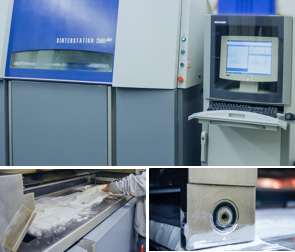Directs a CO2 laser on to a bed of thermoplastic powder sintering (fusing together) the material to the layer below in order to produce a solid 3-dimensional part.

| model/make | Sinterstation 2500plus by 3D Systems |
| mechanism | CO2 Laser |
| materials | PA 2201 (Nylon 12), PA 3200 GF (Glass Filled Nylon 12), and Duraform Flex |
| applications | No supports allow complex geometries with minimal post processing. Durable parts allow for functional applications. |
| pros/cons | Durable nylon based models create functional parts with features such as living hinges and snap fits. The limitation for this process is geometric flatness and accuracy caused by the thermal stress created in the sintering process. |
How it Works
Sinterstation systems use the Selective Laser Sintering (SLS) process to create solid three-dimensional objects, layer by layer, using a computer controlled laser that selectively “sinters” or fuses materials using CO2 laser energy.
Who Uses It
From aerospace to consumer electronics and automobiles to appliances, companies around the world use laser sintering to accelerate the design, development, and market introduction of new products. Users are only limited by their own creativity when it comes to leveraging the durability and ultimate design flexibility of the SLS process. Because of these qualities, an increasing number of customers are also exploring direct digital manufacturing applications with SLS technology, using both commercial and custom SLS powders.
What Materials Does it Use?
The most common materials are powdered nylon 12 based, however nylon 6 and nylon 11, as well as elastomeric-based powders are also widely available. More exotic options include PPSF, polypropylene, metals and ceramics. Internally at the RPC we offer Nylon 12 based PA and Glass filled PA as well as TPE based Duraform Flex.
For Further Questions
Not sure if Selective Laser Sintering is right for your application? Get in touch.